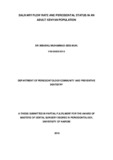| dc.contributor.author | Muhammad, M. | |
| dc.date.accessioned | 2016-11-14T11:25:00Z | |
| dc.date.available | 2016-11-14T11:25:00Z | |
| dc.date.issued | 2016 | |
| dc.identifier.uri | http://hdl.handle.net/11295/97105 | |
| dc.description.abstract | Periodontal diseases are the commonest oral health problems with over 90% of the population suffering from at least one form of this disease. Ng’ang’a’s literature review on oral health status in Kenya reported a prevalence of chronic periodontitis (1-10%) and gingivitis (0.2 – 90%). A recent Kenya National Oral Health Survey (KNOHS 2015) found the overall prevalence of gingival bleeding to be 98.1 % in adults. Several studies have linked periodontitis to alteration in saliva composition and flow rate.
Saliva is an important oral fluid with numerous functions that relate to the normal functioning of the body and maintaining the integrity of the oral tissues including the periodontium. Salivary flow rate is the amount of saliva one produces in a minute. This rate varies from population to population depending on age, sex, diet, geographical location and genetics. It may also be altered by chronic systemic diseases, medication and radiation therapy. The aim of this study was to establish the normal salivary flow rate (SFR) in an adult Kenyan population and relate it to periodontal status.
Study objective: To establish the salivary flow rate in a Kenyan adult population and investigate its relationship with periodontal status.
Setting: Oral diagnosis and Periodontology clinics at the University of Nairobi Dental Hospital.
Study design: A cross sectional study based at the University of Nairobi Dental Hospital. A total of 333 participants were recruited using systematic random sampling. Saliva was collected using spit method and periodontal evaluation was based on the basic periodontal examination (BPE). Plaque and gingivitis were determined using the Quigley Hein Index - (Modified by Turesky et al, 1970) and Silness and Loe 1964 indices respectively. Bio-data and social demographic information was obtained through a questionnaire.
Data Analysis: The data was coded, entered and analyzed using SPSS 20.0 software. Descriptive statistics, independent T-test and ANOVA, Pearson
xii
correlation and linear regression were used to investigate the relationship between the study variables.
Results: A total of 333 participants were recruited in the study with a male to female ratio of 1:1.3. Age range was 18 to 45 years, with a mean of 32.2 years. The saliva flow rate (g/min) ranged between 0.14 – 1.98g/min in males and 0.08 – 1.68g/min in females. The mean SFR was 0.66 ±0.31g/min SD with a mode of 0.30g/min. Two hundred fifty-three participants were normal secretors within the range of 0.3 and 1.0g/min, forty-three were secretors with over 1.0 g/min while thirty-two were low secretors with a range of 0.1 and 0.29g/min.
Using independent sample t test, the periodontitis group had a statistically significant higher mean salivary flow rate (0.7g/min ± 0.3) than the gingivitis group (0.6g/min± 0.3) p = 0.04.
Conclusion: The average unstimulated salivary flow rate of the study population was 0.66g/min, which falls within the reported normal range. Within the limitations of this study, the data suggests that there may be a possible positive relationship between SFR and inflammatory periodontal destruction | en_US |
| dc.language.iso | en | en_US |
| dc.publisher | University of Nairobi | en_US |
| dc.rights | Attribution-NonCommercial-NoDerivs 3.0 United States | * |
| dc.rights.uri | http://creativecommons.org/licenses/by-nc-nd/3.0/us/ | * |
| dc.subject | Salivary Flow Rate And Periodontal Status | en_US |
| dc.title | Salivary Flow Rate And Periodontal Status In An Adult Kenyan Population | en_US |
| dc.type | Thesis | en_US |
| dc.description.department | a
Department of Psychiatry, University of Nairobi, ; bDepartment of Mental Health, School of Medicine,
Moi University, Eldoret, Kenya | |



